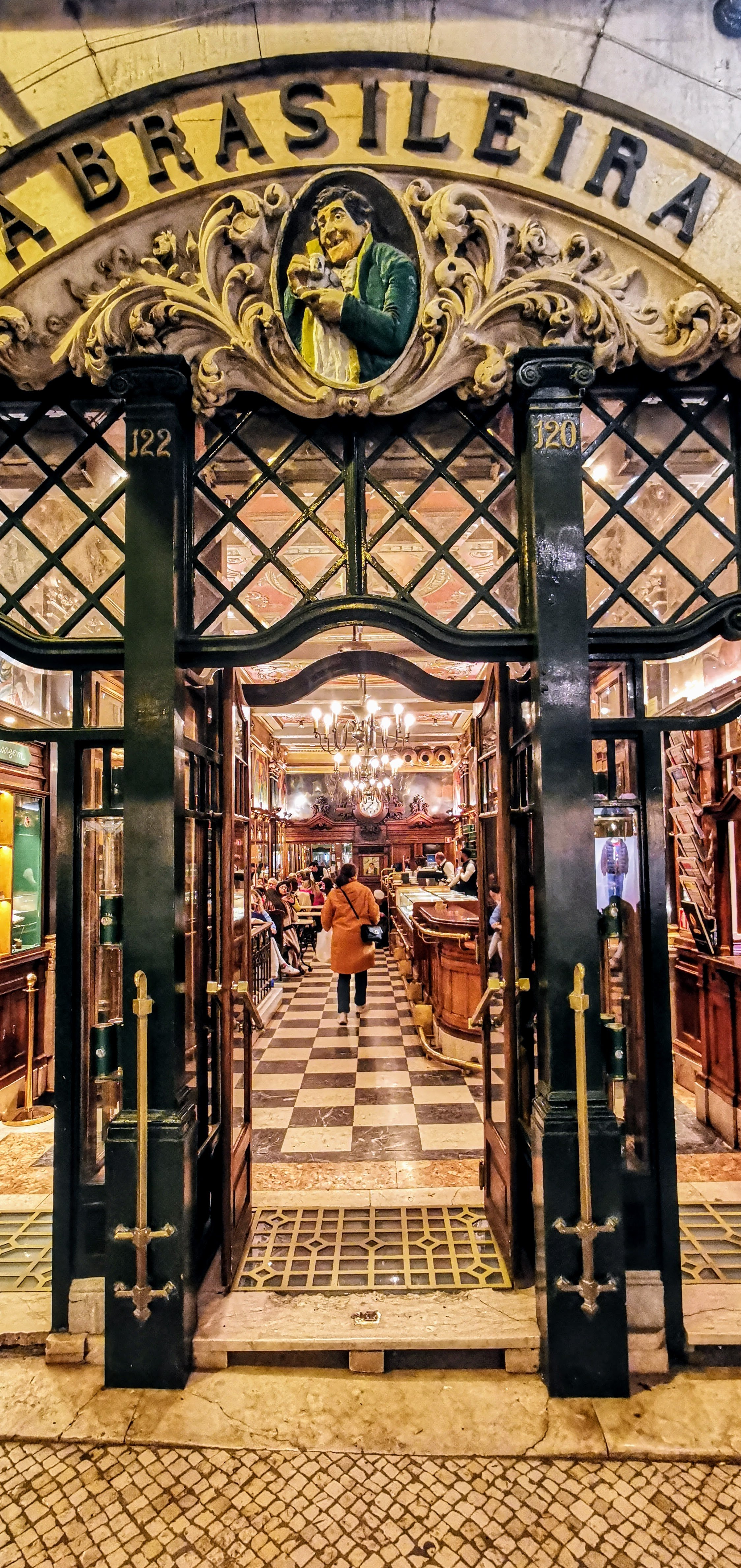LITERARY MYSTERY TRAIL
Cafe culture is an integral part of Lisbon life and Café A Brasileira is now one of the oldest and most famous.
Café A Brasileira do Chiado pulls them in like moths to a flame—locals and tourists alike. Who could resist such a charming little café at the heart of Lisbon's Old Quarter? Two gin and tonics cost me €30, but it was my birthday, so that was by the way!
Fernando Pessoa, pen permanently poised, sits outside A Brasileira where he loved to work.
“ Fernando Pessoa was Portugal’s answer to Robert Burns, Lord Byron, Bob Dylan, and Dylan Thomas - all rolled into one.”
I noticed a gentleman sitting in the corner staring at us. He wasn’t saying much nor moving! It was a statue of Fernando Pessoa, a regular in the 1930s, who sought out the cafe’s quiet corners to read, write, and reflect.
The café was a popular meeting place for Lisbon’s intellectuals, artists, and writers. Pessoa found it the perfect place for listening and observing. Between a “bica” and a few words of conversation, many of his texts were born and the poet’s transformation into one of the greatest literary figures steadily transpired.
PORTUGAL’S GREATEST WRITER
Born in Lisbon in 1888, Pessoa was to become a prolific poet, literary critic, translator, publisher, and philosopher—in fact one of the most significant literary figures of the 20th century, and arguably the greatest poet in the Portuguese language.
Pessoa was famous for writing under dozens of different literary identities, or “heteronyms”—a term he coined himself. These weren’t mere pen names; each heteronym had its own distinct biography, worldview, and writing style.
His main ‘alter-egos’ were Alberto Caeiro, Álvaro de Campos, and Ricardo Reis, each writing on completely different themes and in entirely different voices. While most writers wrestle to sustain one authorial presence, Pessoa juggled more than seventy.
For Pessoa, it was a deliberate creative strategy. His literary dam was literally overflowing!
Campo de Ourique
We took Tram 28 out to Campo de Ourique. I was annoyed that McDonald’s got in my shot. Pessoa had no such inhibitions. He wrote advertising slogans for Coca-Cola.
Exploring further, we took the No 28 tram for Campo de Ourique, a leafy quarter just outside Lisbon’s historic heart. This is a lived-in Lisbon neighbourhood of cafés, bookshops and wide, quiet streets.
For Elsa, my partner, it’s familiar territory—she called Campo de Ourique home during her student days. Campo de Ourique still feels authentic—more small-town than tourist trap. It’s a place where well-dressed Portuguese gentlemen sit sipping Bicas at pavement cafés, looking much as Pessoa did in the 1930s. He was, by all accounts, a very snappy dresser.
If I were a “Little Lettuce” (Pessoa’s whimsical term for a quiet, thoughtful soul), this is the kind of neighbourhood I’d choose to live in. It has an artistic energy, tree-lined streets with plenty of places to sit and contemplate.
Casa Fernando Pessoa
Pessoa lived in Campo de Orique for 15 years from 1920 until he died in 1935. His home is now referred to as ‘Casa Fernando Pessoa’, a museum dedicated to his life and works. It includes an open-access library specialising in Pessoa writing and international poetry.
Casa Fernando Pessoa is worth a visit for anyone interested in literature, history, or the life of one of Portugal’s greatest poets.
Pessoa, The Ad Man
“First you find it strange, then it gets inside you””
Pessoa wasn’t above commercial work—he wrote advertising slogans, even for Coca-Cola. One of his lines in Portuguese rhymed perfectly, though it puzzled locals: Primeiro estranha-se, depois entranha-se (“First you find it strange, then it gets inside you”). Unfortunately for Coca-Cola, the phrase was coined in the middle of Portugal’s dictatorship under Salazar. The Minister of Health reportedly disliked the campaign—“Coke” sounded like “cocaine”—and the drink was banned until democracy was established in the mid 70s, when trade barriers loosened. Coca-Cola quickly gained popularity thereafter.
Final Words
Fernando Pessoa died Hospital de São Luís (St. Louis Hospital) in Lisbon on 30 November 1935, at just 47 years old. Much of his work only became known after his death when a wooden chest containing thousands of undiscovered pages was opened – a literary legacy that would transform Portuguese and world literature.
From his hospital bed, he wrote his final words… in English:
“I know not what tomorrow will bring.”
Pessoa body was interred or "inumaçao" at Prazeres Cemetery next to Campo de Ourique. However, in 1985—to mark the 50th anniversary of his death—his remains were transferred to Jerónimos Monastery (Mosteiro dos Jerónimos) in Belém, Lisbon. Today, he rests there in a grand tomb alongside other major Portuguese cultural figures.
We visited Prezeres Cemetery near Campo de Orique where Pessoa was initially "inumaçao" (inhumation). This elegant, black cat curiously kept following us…
A Brasileira has published one of his books, ‘Mensagem’ (Message) and is available for purchase in the café.






